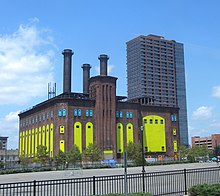
The Powerhouse Arts District is a historic warehouse district in Downtown Jersey City, New Jersey, United States, on the water front of the Hudson River. Its name derives from the unused generating station Hudson and Manhattan Railroad Powerhouse, [1] [2] [3] a historic Victorian-era power plant that was renovated into an arts center. [4] The area was once home to large industrial operations, which gradually left the district during the 20th century, leaving large derelict buildings that attracted artists drawn to the large, affordable loft spaces. [3]

